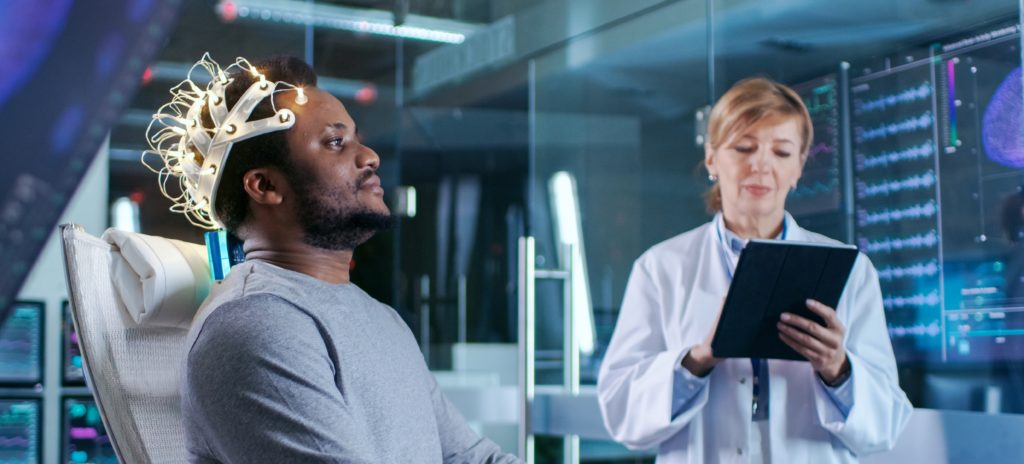Neurofeedback is one of the modules utilized by the patented VRsano method. It helps patients develop a sense of control over their psychophysiological functioning through the measurement and manifestation of brain wave data as events in the VR immersive environment which activate operant conditioning.
In this series of blog posts we break down each of the three main modules of the VRsano method – VR, neurofeedback, and clinical hypnosis. We explain how they are each used traditionally, their benefits and limitations, and how VRsano is employing them in a new, maximally efficient way.

Neurofeedback is the cognitive subdivision of biofeedback, which is the method of presenting an individual with real time data about their own body functions such as heart rate, brainwaves, skin conductance, body temperatures, etc. in order to help them better understand what their body is doing and make it possible for them to control otherwise involuntary bodily functions.
Neurofeedback engages the fundamental learning process of operant conditioning, whereby people act, observe the effects of their action, and then alter the action the next time around until they achieve a desired response. The “desired response” in the case of biofeedback is the alteration of certain physiological markers, whereas in neurofeedback it is the enhancement of certain brainwaves and reduction of others, depending on what brainwave patterns are deemed optimal for the given patient’s needs and abilities. The neurofeedback device helps patients achieve this brainwave optimization by collecting data about users’ brain function via electrodes attached to the scalp.
Benefits
The therapeutic goal is accomplished by reinforcing the expression of the desired brainwaves with some kind of visual or auditory cue until gradually, via the link between the internal feeling and the external reinforcing stimuli, the patient unconsciously begins learning how that brainwave “feels” and becomes able to achieve it more easily. Thus, via repetitive sessions, a gradual neurological shift is achieved in the desired direction due to the brain’s plasticity. Neurofeedback’s healing effects on ADD/ADHD, addictive disorders, cognitive decline, anxiety, autism, depression, epilepsy, OCD, pain and headaches, PTSD, Schizophrenia, optimal functioning and many more have been extensively documented (See Hammond, 2014 for a comprehensive review).
Limitations
The premise of the bio-neurofeedback training includes a general lack of guidance in the process and is based on a “reward” system (achieving a set goal manifested in a form of a sound and/or simple animation) designed to reinforce the corresponding physiological changes. As such it relies on the patients’ ability for insight about what they need to do and an ability for self-control and concentration, and therefore, despite the good success rate if used as intended, the process is long, repetitive, and boring, and as such has a high dropout rate and cannot be used successfully in immediate care.
VRsano
VRsano interconnects the neurofeedback component with Virtual Reality and clinical hypnosis to greatly enhance its effectiveness and minimize its limitations. In VRsano, the neurofeedback component is primarily used for gathering brainwave markers in real time via electrodes on a headband in order to ensure the most beneficial VR output for the patient is delivered. The VR environment contains interactive visual events that respond to the patient’s emitted brainwaves and serve as a “reward” for the change of brainwaves in the desired direction and as feedback to the patient about their current psychophysiological state. The Virtual Reality aspect of the method creates an engaging and interesting virtual landscape to keep the patient’s attention throughout the session and to avoid the common downfall of neurofeedback used alone which often leads to a loss of interest and patience. VRsano seamlessly integrates the neurofeedback component within the VR world and thereby the patient does not feel forced to focus on a narrow target for an extended period of time (for more on VR, see Blog Post 1).
The hypnosis modules on the other hand capitalize on the brainwave training achieved by the neurofeedback component and begin only when the patient’s brainwaves are in an optimal state for the reception of the hypnosis. A portion of the population is not hypnotizable and it is difficult to know who is and who isn’t before a hypnosis session begins. Therefore, the neurofeedback component of VRsano will inform the algorithm whether the patient’s brainwaves match a hypnotizable profile or not. If they do, the hypnosis begins and progresses according to the brainwave data, and if the patients are not hypnotizable, a guided learning module will be employed instead. Guided learning will achieve similar effects as the hypnosis module in terms of helping the patient alleviate distress and learn how to prepare the target area of the body for treatment, but it will be effective for those who cannot be hypnotized (for more on hypnosis, see Blog Post 3).
Resources
Hammond, C., Novian, A. (2014). The ISNR Comprehensive Bibliography of Neurofeedback in Scholarly Articles. Retrieved from: http://www.isnr.net/resources/comprehensive-bibliography.cfm
